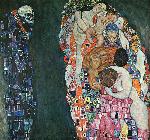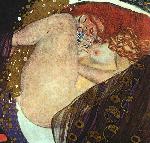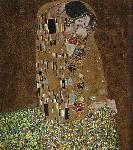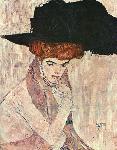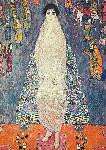Learn About Gustav Klimt in Art History, View His Art and Famous Paintings
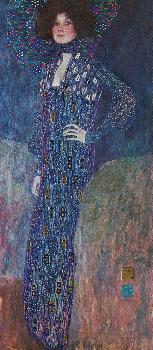
"Emile Floge, 1902, Gustav Klimt
Gustav Klimt, 1862-1918, one of Austria’s famous artists in art history was commissioned to paint one of his famous paintings "The Auditorium of the Old Burgtheater" in 1888. The painting is gouache on paper and is a portrait of who's who in contemporary Viennese life.
 He executed over fifteen hundred portrait sketches for this painting. The painting not only made him a great success with the public, but also made him the most fashionable portraitist of his day by 1893.
He executed over fifteen hundred portrait sketches for this painting. The painting not only made him a great success with the public, but also made him the most fashionable portraitist of his day by 1893.
Whether it is was because of a family death or a rejected appointment to a professorship by the Ministry of Culture, at the Academy of Fine Arts, Gustav Klimt changed direction in his art style from one of academic realism to a more rebellious experimental style.
Classical iconography was replaced by more sensual themes, sometimes unorthodox as in "Love" painted in 1895. Gustav’s art is a realistic portrait of two young lovers meeting in a garden just before dark.
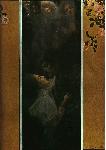 Appearing out of the mist above the lovers are three female portraits symbolizing the different ages of women. The monstrous-looking face on the left possibly represents old age and death.
Appearing out of the mist above the lovers are three female portraits symbolizing the different ages of women. The monstrous-looking face on the left possibly represents old age and death.
Gustav Klimt painted one of his famous paintings "Music" in 1895, an up front, figure active, foreground frieze, consisting of large areas of undelineated form. The work is an early example of "Secessionist" art. The Secessionists were a group founded by artists rebelling against the Kunstlerhaus, a conservative selection committee with power over artist selections.
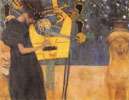
Klimt was elected president of the new association in 1897 and designed the poster for the groups first art showing. Possibly an indication of what was to come in Klimt's future artwork, was his rendering of Theseus painted without a fig leaf, a detail changed later
conceding to propriety of the time. Possibly here too, the concession increased a reactionary dislike for the selection committee that seemed to be an effective force on his painting for the rest his of his life.
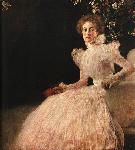
In 1898 Gustav Klimt painted the portrait "Sonja Knips", rendering her dress in an impressionistic style. Changing styles abruptly Klimt painted her facial portrait realistically creating power in her youthful character and a striking painting as a whole.
As successful as the artwork "Sonja Knips" was, "Pallus Athena", 1898 was not. Instead of the classical style of realism in art history, Klimt painted an armored femme fatale holding in her hand Nuda Veritas, a sensual emblem of truth. "Pallus Athena" was seen as a threatening symbol of feminine thought, considered erotic and hostile, and against prevailing norms and standards of the time.
Gustav Klimt began work on "Philosophy"; a work that was destined for the University Aula in 1899. The painting recorded Klimt's views of the world and actually documented his changing art style. His view was that modern man had lost touch with his fundamental existence.
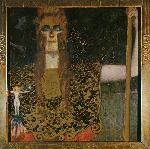
Klimt iconography consisted of disease, old age, sickness, decay, and ugliness. It emphasized the cycle of Nature, being life and death, totally indifferent to inconsequential being of mankind. When the professors finally understood all his iconography in depth they rejected the painting as an attack on orthodoxy.
Reacting to the rejection of "Philosophy", Klimt retaliated painting "Goldfish"

The color gold was used in Gustav Klimt's early artworks mostly symbolizing sacred objects exampled by the helmet and armor worn in "Pallus Athena". At the same time in 1898 Klimt began to associate gold with sexual appeal and also with the picture "Goldfish". He continued the erotic sensual art compositions for the rest of his life, searching for happiness in life.
Klimt also painted landscapes. He painted "Country Garden with Sunflowers", 1905, and "Poppy Field"1907, a painting on first glance seeming to be impressionist art, but actually going beyond impressionism in its definition of space.
 He uses flat overlapping areas of decoration without value changes creating depth. The flat foreground trees overlap the poppy field and the deep background trees. Size, spacing, and the flat colored paint daubs also play a part creating space.
He uses flat overlapping areas of decoration without value changes creating depth. The flat foreground trees overlap the poppy field and the deep background trees. Size, spacing, and the flat colored paint daubs also play a part creating space.
Gustav Klimt's art style changed again when he painted one of his famous paintings in art history "Friedericke Maria Beer"in 1916, a portrait influenced by oriental philosophy. The painting is very ornamental in its colored patterns and extremely two dimensional to the point where the portrait is almost lost except for the intense black color of her hair.
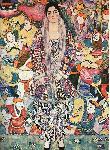 The background is very different in that it is filled with fighting oriental figures possibly symbolizing something Klimt never revealed. Other famous artists of Twentieth Century Painting are Pablo Picasso and Marc Chagall.
The background is very different in that it is filled with fighting oriental figures possibly symbolizing something Klimt never revealed. Other famous artists of Twentieth Century Painting are Pablo Picasso and Marc Chagall.
View gallery #2 of Klimt paintings
Click on the graphics below to increase graphic sizes. At the same you time can also view an opportunity to purchase a poster or painting reproduction.
